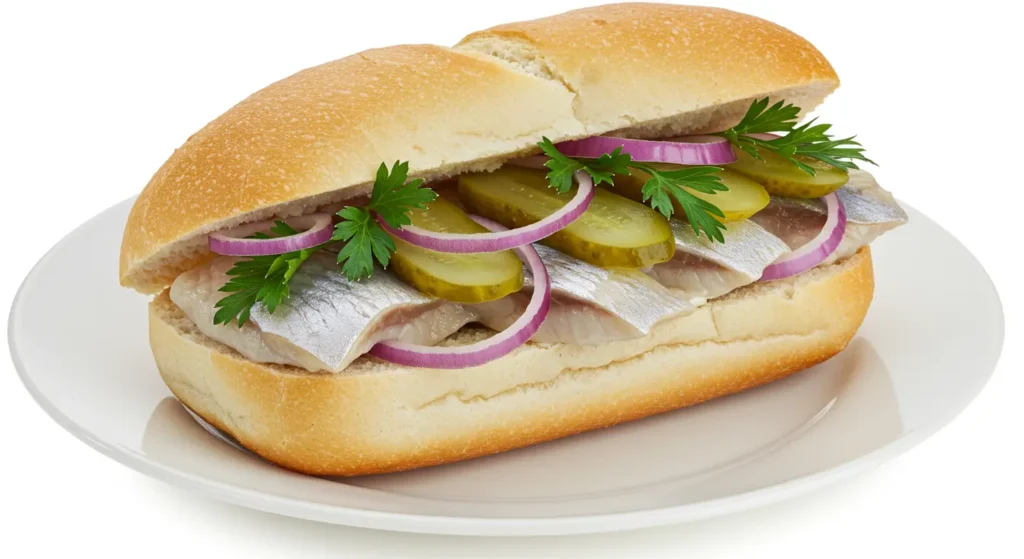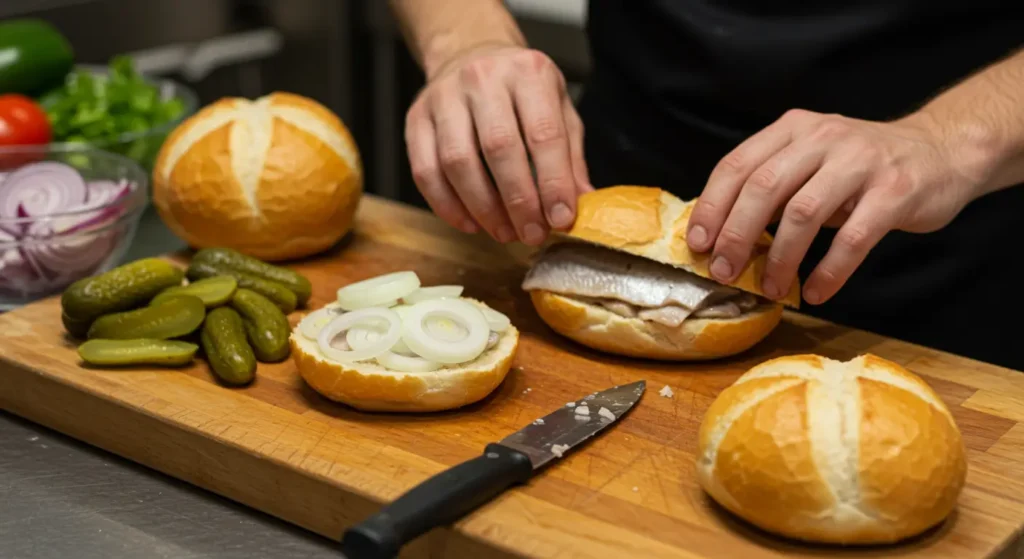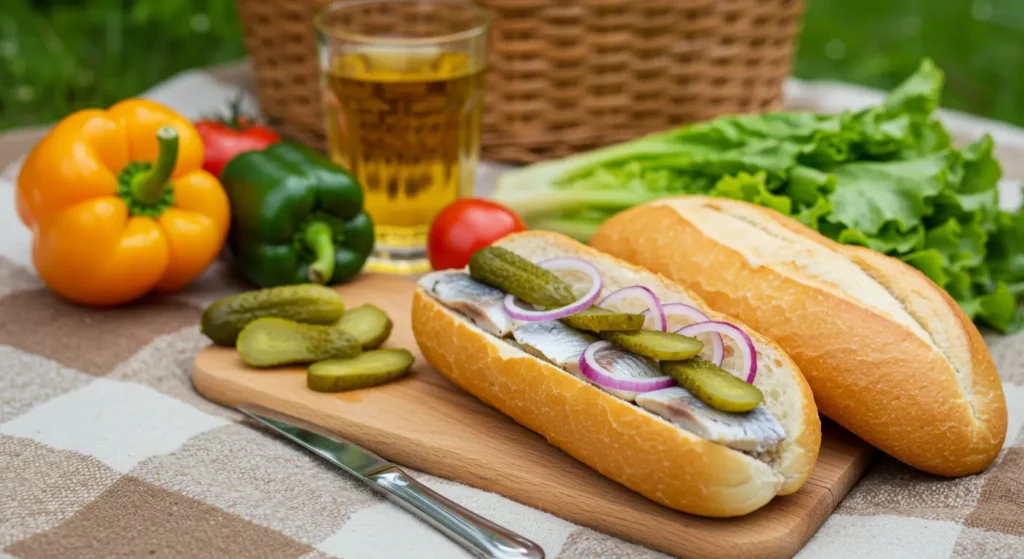What is a Matjesbrötchen?
A Matjesbrötchen is a traditional German sandwich that consists of marinated herring fillets known as “Matjes” placed inside a fresh, soft roll or bun. This dish is particularly popular in Northern Germany and often enjoyed as a snack or light meal. Chefs specially prepare the herring used in a Matjesbrötchen, typically curing it in a brine or vinegar-based marinade, which gives it a mild and slightly tangy flavor.

Table of contents
History of Matjesbrötchen
The Matjesbrötchen has its origins in the maritime culture of Northern Germany, where herring has been a staple food for centuries. Historically, herring was one of the most important fish for coastal communities, providing a reliable source of protein and essential nutrients. The tradition of marinating and preserving herring began in the Middle Ages when people used salt to prolong the shelf life of fish, making it an ideal option for trade and consumption.
The concept of the Matjesbrötchen as a sandwich likely emerged in the late 19th century, as the rise of the industrial revolution in Germany led to urbanization and an increased demand for quick, easy-to-eat meals. In the cities along the North Sea and the Baltic Sea, where fresh fish was abundant, it became a convenient and popular snack for workers, fishermen, and locals alike. The combination of soft rolls and marinated herring reflected the German preference for simple yet flavorful meals that people could enjoy on the go.
While the Matjesbrötchen has evolved over time, it remains deeply rooted in German tradition. The seasonal nature of the fish used in the sandwich has kept it tied to specific times of the year, particularly in the summer months, when young Matjes herring is available.Today, people still enjoy it in various forms across Germany, especially during festivals or at local fish markets, where vendors often serve it with regional accompaniments like onions, pickles, or even a dollop of sour cream.
How to Prepare Matjesbrötchen at Home
Making a Matjesbrötchen at home is straightforward and requires only a few simple steps. By using fresh, quality ingredients and following the traditional method, you can easily recreate this popular German sandwich. Here’s how to prepare a delicious Matjesbrötchen in your own kitchen:
Ingredients:
- 2 Matjes herring fillets (marinated)
- 2 soft rolls or buns
- 1 small onion (thinly sliced)
- 2-3 pickles (sliced)
- Fresh dill (optional)
- Butter or mayonnaise (optional)
Instructions:
- Prepare the Ingredients
Start by draining the Matjes herring fillets from the marinade, ensuring they are not too salty. Lay them flat on a cutting board, and if necessary, cut them into smaller pieces to fit inside the rolls. - Prepare the Rolls
Slice the rolls or buns in half. You can toast the rolls lightly if you prefer a crisp texture, but traditionally, Matjesbrötchen is made with soft, fresh bread. If you like, spread a thin layer of butter or mayonnaise on the inside of each roll to enhance the flavor. - Assemble the Sandwich
Place the Matjes herring fillets inside the rolls, making sure to distribute them evenly. Top the herring with thin slices of onion and pickles. The pickles add a tangy contrast, while the onions provide a mild sharpness. - Add Fresh Herbs (Optional)
For an added burst of flavor, sprinkle some fresh dill or parsley over the sandwich. This is optional, but it complements the herring beautifully. - Serve and Enjoy
Once assembled, it is ready to serve! It’s best enjoyed immediately while the bread is soft and fresh, but it can also be stored in the refrigerator for a few hours if you want to prepare it ahead of time.
The beauty of the Matjesbrötchen lies in its simplicity. With just a few ingredients, you can create a sandwich that is both flavorful and satisfying. This dish is perfect for a quick meal, snack, or picnic.

Regional Variations of Matjesbrötchen
While the Matjesbrötchen is a beloved dish across Germany, its preparation and presentation can vary depending on the region. Different regions put their own spin on this classic sandwich, offering slight variations in ingredients or serving style. Below are some regional twists on the traditional Matjesbrötchen that you might encounter:
Northern Germany
In Northern Germany, where the Matjesbrötchen originates, people typically prepare the dish with fresh, soft rolls. They usually serve the herring fillets with thinly sliced onions and pickles, often accompanying it with a drizzle of mustard or a dollop of mayonnaise.The emphasis is on the simplicity of the ingredients, allowing the delicate flavor of the Matjes herring to shine. This variation is often eaten as a snack or light meal, particularly during the summer months when the herring is in season.
Schleswig-Holstein
In the Schleswig-Holstein region, located in the far north of Germany, people often pair the Matjesbrötchen with an additional layer of freshly chopped herbs like parsley or dill. People often eat this variation as a snack or light meal, particularly during the summer months when the herring is in season.
Westphalia
In Westphalia, a region in central Germany, people sometimes serve the sandwich with a more substantial bread, such as a rye or multi-grain roll, providing a heartier base. They often chop the pickles more finely or even mash them, adding a slightly different texture.The use of a stronger vinegar-based marinade for the herring is also common in this region, giving the sandwich a more pronounced tanginess.
Berlin and Surrounding Areas
In Berlin, people often serve it in a more contemporary style, sometimes with a variety of artisan rolls or bread. Berliners may also incorporate roasted onions for a deeper, caramelized flavor.
Friesland and Lower Saxony
In Friesland and Lower Saxony, regions along the North Sea, locals often pair Matjesbrötchen with a slice of apple or fresh cucumber for a refreshing twist. They sometimes serve the herring fillets in a more rustic style, with a larger portion of herring and minimal garnishing to let the fish take center stage.
Each region’s take on Matjesbrötchen reflects local tastes and traditions, but all versions celebrate the fresh, tangy flavor of marinated herring. No matter where you are in Germany, the core ingredients of the dish remain the same, offering a true taste of German culinary culture.
Matjesbrötchen Serving Suggestions
A Matjesbrötchen can be enjoyed in various ways, depending on the occasion and personal preferences. Whether you’re serving it as a quick snack, a light lunch, or as part of a larger spread, there are several ways to elevate the experience. Here are some serving suggestions to consider:
Serve with Fresh Sides
Pairing your Matjesbrötchen with fresh, complementary sides can enhance the meal and add variety. Some classic side options include:
Sliced Tomatoes and Cucumbers: Light, fresh vegetables like tomatoes and cucumbers provide a cool, crisp contrast to the salty and tangy herring.
Potato Salad: A creamy, tangy potato salad is a great accompaniment to the Matjesbrötchen. The richness of the salad balances the sharpness of the herring and provides a satisfying texture contrast.
Crisp Salad Greens: A simple green salad with a light vinaigrette can add a refreshing element to the meal. Consider using mixed greens, arugula, or baby spinach for an extra layer of flavor.
Matjesbrötchen as a Picnic Dish
The Matjesbrötchen is also ideal for a picnic or outdoor gathering. To make it more portable, you can wrap the sandwiches in parchment paper or foil for easy transport. Serve the Matjesbrötchen alongside additional finger foods such as fresh fruit, cheese, and crackers for a complete picnic spread.

Matjesbrötchen for Special Occasions
While the Matjesbrötchen is often enjoyed as a casual snack, it can also be served during special occasions. For a festive touch, consider preparing the sandwiches on a platter with a variety of toppings. Such as hard-boiled eggs, capers, and fresh herbs. This can add a more refined feel to the dish when served at gatherings or celebrations, such as seafood-themed dinners or summer barbecues.
Varying the Bread
To suit different preferences or add a unique twist, try serving the Matjesbrötchen on different types of bread. While the traditional soft rolls are the most common choice, you can experiment with various bread options:
- Whole Wheat Rolls: For a heartier and more nutritious option, whole wheat rolls provide a nutty flavor that pairs well with the herring.
- Rye Bread: A slightly denser rye bread adds a tangy and earthy flavor, complementing the Matjes in a different way.
- Sourdough: The slight tang of sourdough bread can provide a unique contrast to the marinated herring, adding a bit of extra flavor complexity.
These serving suggestions let you enjoy the Matjesbrötchen in a variety of settings, making sure that this simple yet flavorful dish adapts to suit any occasion.
For a fresh side dish that pairs perfectly with your Matjesbrötchen, try our cebolla ensalada recipe for a flavorful onion salad.
Matjesbrötchen in Modern Cuisine
Here’s how Matjesbrötchen is making its mark in modern gastronomy:
Creative Presentations
In modern cuisine, chefs often present the Matjesbrötchen in new and innovative ways. While the traditional sandwich remains a staple, many chefs opt for more contemporary serving methods. For example, instead of serving it as a sandwich in a roll, chefs may deconstruct the Matjesbrötchen. And serve it as a salad, with the marinated herring fillets on a bed of mixed greens, garnished with pickles, onions, and fresh herbs. This allows for a more elegant and visually appealing presentation while retaining the dish’s core flavors.
Fusion Dishes
The rise of fusion cuisine has led to new takes on the Matjesbrötchen, combining it with other culinary traditions. For instance, you can incorporate Matjes herring into sushi rolls or serve it as a topping on open-faced sandwiches. These fusion versions bring a fresh perspective to the classic sandwich. Appealing to a wider range of tastes while honoring the dish’s roots.
Healthier Adaptations
As the demand for healthier and more sustainable dining options increases. Many chefs have begun adapting the Matjesbrötchen to meet these needs. For example, you can use whole grain or gluten-free bread to provide a healthier base. Additionally, you can incorporate lighter ingredients, such as non-fat Greek yogurt instead of mayonnaise.
Furthermore, you can prepare Matjesbrötchen with locally sourced, sustainable fish options, reflecting modern culinary trends toward environmental responsibility. Using ethically sourced seafood ensures that the dish remains aligned with the principles of modern sustainable eating.
Vegetarian and Vegan Alternatives
In response to the growing popularity of vegetarian and vegan diets, some chefs are offering plant-based versions of the Matjesbrötchen. Instead of traditional herring, they might use marinated vegetables. Such as eggplant or zucchini, that mimic the texture and tanginess of the fish. Vegan mayonnaise or other plant-based spreads can replace the usual creamy accompaniments. These variations allow those who follow vegetarian or vegan diets to enjoy a similar flavor profile. And keeping the dish cruelty-free.
Matjesbrötchen in Street Food Culture
As street food continues to grow in popularity worldwide. Matjesbrötchen has found its way into food trucks and casual eateries, especially in German cities. Here, they often serve it in a more casual, sometimes pairing it with a variety of toppings like avocado, radishes, or even spicy salsas. This adaptation allows people to enjoy a quick and delicious meal that stays true to the roots of the Matjesbrötchen while offering a fun, modern twist.
Influence on Global Dishes
While the Matjesbrötchen deeply ties into German culinary tradition, people increasingly feel its influence in global dishes. The idea of marinated fish paired with fresh bread and vegetables in other countries’ takes on seafood sandwiches. Such as Scandinavian and Dutch open-faced sandwiches. The concept of Matjesbrötchen has contributed to a broader appreciation for pickled and fermented fish in modern cuisine. Especially within European and international food trends.
If you’re interested in experimenting with different ingredients in your dishes, you might want to check out our vanilla paste recipe, which adds a unique twist to various desserts.
FAQS
What kind of fish is matjes?
Matjes is a type of young herring, typically caught before it reaches full maturity.
What is the difference between herring and matjes?
Matjes is a specific type of herring that is marinated in brine or vinegar, while regular herring is often pickled or smoked.
How do you eat matjes?
Matjes is typically served in sandwiches (Matjesbrötchen), on crackers, or with bread, accompanied by onions, pickles, and herbs.
Is matjes herring healthy?
Yes, matjes herring is rich in omega-3 fatty acids, protein, and essential vitamins, making it a healthy option when eaten in moderation.

2 thoughts on “Matjesbrötchen Recipe: A Classic German Delicacy”